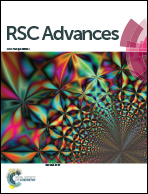Comparing l-lactide and ε-caprolactone polymerization by using aluminum complexes bearing ketiminate ligands: steric, electronic, and chelating effects†
Abstract
Our previous studies on the ring-opening polymerization of ε-caprolactone using aluminum complexes bearing ketimine ligands as pre-catalysts with benzyl alcohol as an initiator clearly showed how the steric, electronic and chelating effects influenced the polymerization rate. Herein, the L-lactide polymerization rate of a series of Al complexes bearing ketimine ligands was also investigated, and the polymerization characteristics between L-lactide and ε-caprolactone were compared. The kinetic results revealed complexes with more steric hindrance ligands that demonstrated greater propagation activity of the CL polymerization; however, an opposite trend was obtained in the L-lactide polymerization because of the larger size of L-lactide hindering its coordination with Al atoms in the crowded surroundings. The electron-withdrawing group of ligands, or less chelating ligands, demonstrated greater propagation activity both in L-lactide and ε-caprolactone polymerization.


 Please wait while we load your content...
Please wait while we load your content...